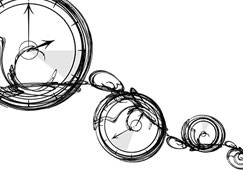Marketers must make more time, not more meetings
Author: CIM PR team

Bruce Daisley has something of a reputation for work-life balance, broadly setting a series of rules that amplify the power of ‘nothing to do’; namely, finding the time to step away from stress and, in these moments, potentially find creative solutions.
When the Catalyst team met up with Daisley, the author of The Joy of Work expressed his desire for people to do a good day’s work and then go home. This is a different way of thinking about working life as Britain remains in the midst of a near productivity crisis. But he is not alone; this month Helen Whately MP made headlines for proposing a bill to make flexible working the default for employers.
However, as the marketing function becomes more and more central to business operations, the ability to have an effective work-life balance for marketers becomes harder and harder. Recently, we have spoken about the companies attempting to trial a four day working week, but working smarter, not harder, is a vague concept without understanding the practicalities of the modern working world.
The United Kingdom has always been a hub for tourism and the travel industry has seen a lot of changes in the past few years. These have included the change to an experience economy, the rise of sites such as TripAdvisor heralding the power of recommendations and the personalisation of big data. This in turn has meant that marketing professionals working in the sector need to be able to undertake a range of different skills and marketing activities requiring them to squeeze more into each day than ever before. So how can this be achieved?
[Cross head: The creativity conundrum]
Whether marketers are working flexibly or not, keeping creativity flowing in the corporate environment is crucial to ensure big ideas thrive. Taking time to foster creative thinking has never been more critical, at a time when marketers are increasingly asked for bigger, better campaigns that deliver real business value. In the modern workplace, this can be a real challenge.
With a little help from Bruce Daisley, we offer a few tips to help you find the headspace you need to help inspiration strike:
1) Schedule less, think more
How often do you find yourself in meetings at work, and how often do those meetings feel productive? It’s often the culture to be seen as networking or meeting other areas of the business – marketing is the department best placed for that – but Daisley suggests this is the wrong approach. “If you look at someone’s diary for the day and see there are no meetings in it, we’ve got a feeling that somehow they can’t be working. But when you look at where creativity and inventiveness happens, it often happens in the gaps in-between everything else”.
2) Halve your meeting attendees
Now that it is easier to schedule meetings than ever before via tools such as Microsoft Outlook, the average worker spends two days of their working week in them; and there is the temptation to invite more and more of your co-workers. “If you invite 12 people, that’s 12 meeting hours. If there are only six, that’s only six meeting hours”, says Daisley. This will leave space in your diary, and, when the space is there, the room to be creative means new ideas are suddenly possible.
3) Shake up your work environment
Speaking of good ideas, how often do we have good ideas in unexpected places, such as the bath or during a run. We are not alone in this, even Albert Einstein felt that he never came up with a good idea by process of rational thought. So, take time to do nothing productive at all because, as Daisley says people ‘who realise that their ideas are accessed by not being constantly busy are going to be the ones finding a competitive advantage.’
4) Take the time to reflect
Time is often viewed as the most valuable currency, and with good reason, but that doesn’t mean we always spend it wisely. Taking time to reflect and regroup your thoughts can mean the difference between a creative breakthrough and a mind blank.
Nonetheless, as Direct Line Group’s marketing director Mark Evans argues in July’s Catalyst, we are not going to find ground-breaking insights if we keep looking for them in the same place. It is the process of looking for these insights, however, that can pose problems for time-poor marketers. In reality, British workers are working, on average, 469 unpaid hours every year, a process that is not only affecting morale, but is encouraging a practice of unpaid overtime that is leaving workers broke. The intervention of Bruce Daisley, and other high-level marketers, to steer this conversation towards employees finding space outside of work to make creative headway, is a welcome development.
If you’re looking for a moment of reflection, be sure to check out CIM’s member-only publication for senior marketers. Catalyst magazine provides a solution for time-poor professionals to keep up to date with the latest marketing ideas, thought leadership and opinions from business leaders. With a wide-reaching global focus, we bring you the latest insights on topics such as leadership, behavioural economics and sociology. Thought provoking, easy-to-digest articles on leading industry figures, such as Bruce Daisley, offer career-enhancing content for the modern marketer.
We don’t want you to miss out on the latest learnings, so if you’re not currently a member of CIM, you can now access Catalyst Lite, which will give you a taste of how our content could benefit you before you sign up.
Ultimately, as marketing becomes a greater part of the overall business mission, more must be done to ensure that marketers are given the time to be creative and inspired. Read more on this topic and many others in the latest edition of Catalyst magazine.